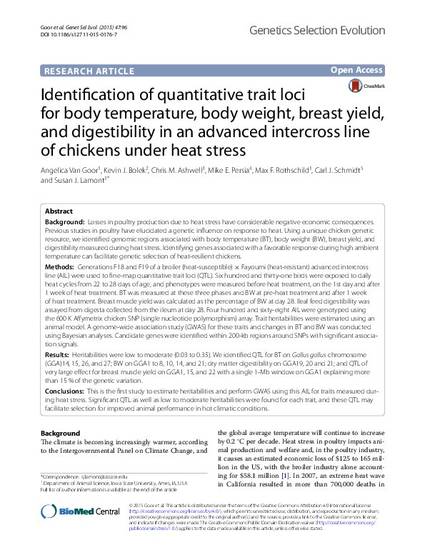
Background: Losses in poultry production due to heat stress have considerable negative economic consequences. Previous studies in poultry have elucidated a genetic influence on response to heat. Using a unique chicken genetic resource, we identified genomic regions associated with body temperature (BT), body weight (BW), breast yield, and digestibility measured during heat stress. Identifying genes associated with a favorable response during high ambient temperature can facilitate genetic selection of heat-resilient chickens. Methods: Generations F18 and F19 of a broiler (heat-susceptible) × Fayoumi (heat-resistant) advanced intercross line (AIL) were used to fine-map quantitative trait loci (QTL). Six hundred and thirty-one birds were exposed to daily heat cycles from 22 to 28 days of age, and phenotypes were measured before heat treatment, on the 1st day and after 1 week of heat treatment. BT was measured at these three phases and BW at pre-heat treatment and after 1 week of heat treatment. Breast muscle yield was calculated as the percentage of BW at day 28. Ileal feed digestibility was assayed from digesta collected from the ileum at day 28. Four hundred and sixty-eight AIL were genotyped using the 600 K Affymetrix chicken SNP (single nucleotide polymorphism) array. Trait heritabilities were estimated using an animal model. A genome-wide association study (GWAS) for these traits and changes in BT and BW was conducted using Bayesian analyses. Candidate genes were identified within 200-kb regions around SNPs with significant association signals. Results: Heritabilities were low to moderate (0.03 to 0.35). We identified QTL for BT on Gallus gallus chromosome (GGA)14, 15, 26, and 27; BW on GGA1 to 8, 10, 14, and 21; dry matter digestibility on GGA19, 20 and 21; and QTL of very large effect for breast muscle yield on GGA1, 15, and 22 with a single 1-Mb window on GGA1 explaining more than 15 % of the genetic variation. Conclusions: This is the first study to estimate heritabilities and perform GWAS using this AIL for traits measured during heat stress. Significant QTL as well as low to moderate heritabilities were found for each trait, and these QTL may facilitate selection for improved animal performance in hot climatic conditions.
Available at: http://works.bepress.com/max-rothschild/63/

This is an article from Genetics Selection Evolution 47 (2015): 1, doi:10.1186/s12711-015-0176-7. Posted with permission.